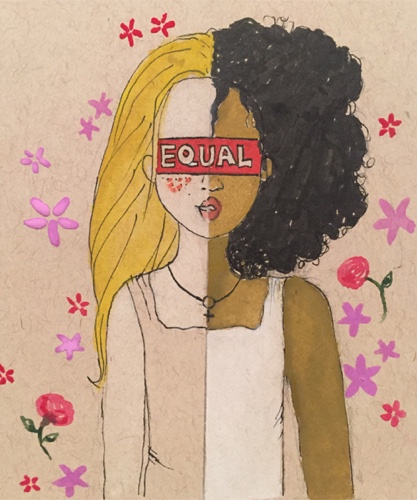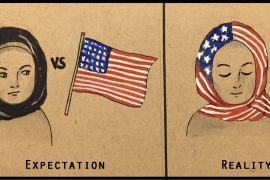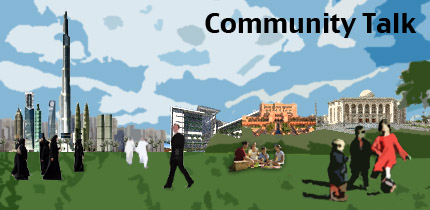Recounting stories from Instagrammers of different ethnicities and nationalities, we see that racism and sexism are part of every woman’s daily life. Women cannot choose to be either their gender or their race and, hence, they fight against both racial and female inequalities. The question I pose to you is should feminism and race merge to address the issues faced by women of color, or should they remain exclusively mutual?

After reading ‘Why I No Longer Talk to White People About Race’ by Reni eddo-lodge, I posted a toll on my Instagram account, @the.intellectual, asking people of different ethnicities, backgrounds, and nationalities whether race should be addressed when tackling feminism or whether they are two separate issues.
When I first read the results, I have to admit I was somewhat disheartened seeing that 54% thought that the two issues are mutually exclusive. Most of the 54% were those who were not ethnically white and, hence, they were systematically discriminated against. Voicing my concern, I received countless moving messages from non-white Instagrammers explaining to me why the two issues cannot be merged, regardless of their overlapping nature. The firsthand struggles in the stories I received showed me that Eddo-Lodge’s opinions were not representative of all, even though I agree with most of her arguments.
In the eye-opening chapter titled ‘The Feminist Question’, Eddo-Lodge strongly expresses that race and feminism are interwoven and should be tackled as one issue. It is true that we are as much our race as we are our gender; we cannot choose to be one and not the other.
Women of color or who are part of ethnic minorities are discriminated against because of their race and their gender simultaneously. Dr. Kimberlè Crenshaw, a scholar of critical race theory, created the term ‘intersectionality’ to describe the merge between racism and sexism, in other words, anti-racism and feminism.
I strongly believe that feminism should appear as a powerful, united front when fighting against female inequality. It is important to note that, in the context of predominantly white societies, females who are white face different degrees of discrimination than women of color experience. I believe this applies in the case of all societies that have ethnic minorities and suffer from racism. For example, the wage gap between white men and women of color are much greater than the gap between white men and white women[1]. These experiences and inequalities are neither addressed nor expressed in feminist groups that are predominantly white.
In contrast, it is the general gender wage gap that benefits the empowered race. In the light of this, I do agree with Eddo-Lodge when she says that white feminism “becomes a problem when its ideas dominate the narrative – presented as the universal, to be applied to all women, because then, we consider humanity in the prism of whiteness”.
It was not until Grey, a non-white Instagrammer, shared a touching story with me that I began to see why the vote turned out this way. He spoke of his feminist mother and sister, who fight against the gender and racial discrimination they face on a daily basis. He states, “The world often functions in such an insecure and childish manner, that they only know how to deal with one at a time.” By “the world”, I think he is referring to the world of white politics that prefer to use colorblindness with the excuse that talking about race only instigates racism.
Women of color are often discouraged, whereby the main argument is to focus on female and not racial empowerment, which often means conforming to the white opinion of what is a priority in the feminist agenda. Even when the creation of ethnic racist groups occur, their voices are not as loud as white feminist groups, because white tends to be considered the default and the more relatable image. For example, feminism in the Middle East seeks different types of female equality than in the west, but many women mimic white feminism because their words are heard.
When I talk about feminism in Europe, I am encouraged to talk about the gender pay gap and I see how women stare me down when I mention my experiences as a Middle Eastern woman living in a white-dominated society. I see women rolling their eyes at best and others openly voicing undermining jokes at worse. On days like that, I started fighting for my Arab identity instead of women equality and that turned me into the ‘closedminded-ignorant-undisciplined Arab’. On days like that, I stop fighting for feminism, which drastically weakens feminist power and its agenda when we count the exclusion of all non-white females. On days like that, I wish that feminism and anti-racism were merged into one because, as another Instagrammer put it, “If it’s all one fight it becomes stronger and louder”.
Grey’s story, coupled with the other experiences that have been shared with me, shed light on the matter of communication. Is addressing the merged issues of racism and sexism the best way to progress in eradicating discrimination against women? In the many times, I have been made uncomfortable to speak about the unique experiences I had due to my race, I learned to speak strategically in terms of what words I use and what topics to broach. Sometimes, I have to let go of some issues to fight for the bigger picture. Surely, progress would be slower in addressing issues that matter to women of color, but at least my voice is heard loud and clear.
It seems like I am an outsider prying on the hardships and experiences of people who are truly suffering, but this whole ordeal affects me because I am not ethnically white regardless of my skin tone. I am an Arab woman living in a country dominated by the ‘white man political ideology’, regardless of the fact that it I reside in one of the most diverse cities in the world. White Europeans always have the upper hand in multicultural discussions and debates. My opinions were seen as less important or were bashed by my classmates and teachers in school, deeming my experiences as an Arab as unreal. I know how it feels like to be seen as the ‘angry-aggressive outsider’. There were many times when I found that I had to change the way I speak to address issues because of my ethic standing in a group. I am Arab, and that is not always the most favorable race.
So, I fought for my Arab identity by using the same undermining smirks they regard other ethnicities with, by quoting white scholars to further my point, and by remaining composed and confident. I fought for female equality by aligning myself with the white agenda, while asserting the need for reforms. That’s the best way to speak loud and clear in a society that systematically discriminates. We need to navigate around the white system because, in Eddo-Lodge’s words, “Every voice raised against racism chips away at its power. We can’t afford to stay silent”.
References
[1] Miller, Kevin. “The Simple Truth about the Gender Pay Gap.” AAUW: Empowering Women Since 1881. Accessed July 15, 2018. https://www.aauw.org/research/the-simple-truth-about-the-gender-pay-gap/.



